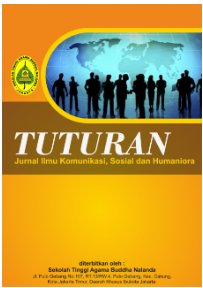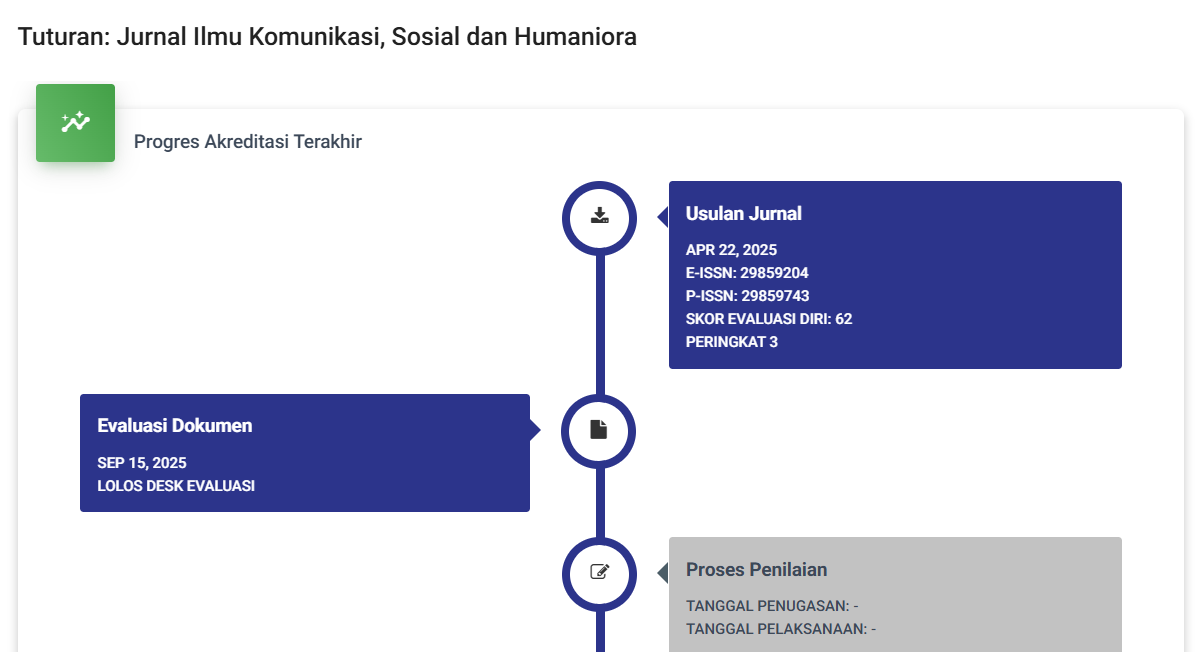Pengaruh Loyalitas Fanbase Alwi Assegaf terhadap Sikap Menonton Sinetron Raden Kian Santang di MNCTV
Survei pada Akun Istagram @fsaai_officiall
DOI:
https://doi.org/10.47861/tuturan.v2i4.1225Keywords:
Fanbase Loyalty, Attitude of Watching, Raden Kian SantangAbstract
Mass media and the current information technology, can provide positive and negative impacts. One of them is the visual television program that can influence the public's viewing attitude. This study aims to measure the Influence of Alwi Assegaf's Fanbase Loyalty on the Attitude of Watching Raden Kian Santang, a television program that is famous for the presence of Alwi Assegaf as one of the main roles in it. This study uses a quantitative method by distributing questionnaires to active Alwi Assegaf fanbase members with a sample size of 84 people. This study has two variables, namely Fanbase Loyalty and Viewing Attitude. The audience loyalty variable in this study is measured using the dimensions of Internal Involvement, External Involvement, Desire to Acquire and Interaction. To measure the viewing attitude variable, this study uses the dimensions explained by Suryanto, namely, Cognitive, Affective and Conative. The results of the study indicate that Alwi Assegaf Fanbase Loyalty is a variable that has been studied and obtained a positive assessment, this has been proven through the total average value that has been calculated at 44.39, Attitude to watch Raden Kian Santang is a variable that has been studied and obtained a positive assessment, this has been proven through the total average value that has been calculated at 42.42, For a simple regression test, the results obtained were 0.826, which means that the relationship or correlation between the Alwi Assegaf Fanbase Loyalty variable has a high or strong influence on the Raden Kian Santang Watching Interest variable. For the hypothesis test, the results obtained were 1.663. The calculated t value (3.594)> t table (1.663) then it can be concluded that H0 is rejected and H1 is accepted, which shows that there is an influence between the Alwi Assegaf Fanbase Loyalty variable! (X) with the Attitude to Watch Raden Kian Santang
References
Amara, D., & Putri, I. P. (2020). Pengaruh context, communication, collaboration, connection pada akun Twitter @Jokoanwar terhadap minat menonton film Gundala. E-Proceeding of Management, 7(2), 7302–7314.
Atmoko, B. D. (2012). Instagram handbook. Media Kita.
Azwar, S. (2015). Sikap manusia: Teori dan pengukurannya (Edisi ke-2). Pustaka Pelajar.
Bacchi, C., & Goodwin, S. (2016). Key themes and concepts. In Poststructural policy analysis: A guide to practice (pp. 27–53).
Cangara, H. (2019). Pengantar ilmu komunikasi (Edisi kelima). PT RajaGrafindo Persada.
Djamal, H., & Fachruddin, A. (2022). Dasar-dasar penyiaran: Sejarah organisasi, operasional, dan regulasi. Prenada Media.
Endrayanto, S. (2012). Statistika untuk penelitian. Graha Ilmu.
Habibi, H., & Mardhiyah, A. (2021). Analisi penerapan layanan pickup and delivery terhadap loyalitas konsumen (Studi pada Cuci Sepatu Medan).
Hilaliyah, Z., & Hendrastomo, G. (2021). Fenomena K-Pop sebagai konsumsi budaya populer di kalangan santriwati di Pondok Pesantren Al Barokah Yogyakarta. E-Societas, 10(2), 2–21.
Hurriyati, R. (2010). Bauran pemasaran dan loyalitas konsumen. Alfabeta.
Ivana Rawung, L. (2017). Kolektivitas virtual fandom: Kajian netnografi pada fandom “Sone” di media sosial Instagram. Universitas Gadjah Mada.
Jauhari, H. (2013). Jurnalisme televisi Indonesia. Kepustakaan Populer Gramedia.
Nasrullah, R. (2015). Media sosial: Perspektif komunikasi, budaya, dan sosioteknologi. Simbiosa Rekatama Media.
Nederveen Pieterse, J. (2020). Global culture. Theory, Culture & Society, 37(7-8), 233-240.
Oktaviana, Y. (2020). Analisis loyalitas konsumen dalam pembelian tiket pesawat di agent travel PT. Chandra Buana Utama Kalimantan Kabupaten Kapuas.
P. Dibia Atmaja, N. N. Yulainthini. (2020). Pengaruh relationship marketing dan kepuasan pelanggan terhadap loyalitas pelanggan Indihome pada PT. Telkom Datel Singaraja. Universitas Pendidikan Ganesha, Jurnal Manajemen dan Bisnis, 2(2).
Rahmawati, I., & Rusnandi, D. (2011). Berkarier di dunia broadcast televisi & radio. Laskar Aksara.
Risti, D. (2019). Pengaruh sinetron terhadap perilaku anak di dalam kehidupan sehari-hari. Indonesian Journal of Primary Education, 3(2), 38–45.
Seregina, A. (2011). Fanaticism – Its development and meanings in consumers’ lives. (Disertasi, Aalto University).
Shivadas, P. (2021). Discourse on fandom in modern India: Where do we stand? In Hero and hero-worship: Fandom in modern India (pp. 17).
Simbar, F. K. (2016). Fenomena konsumsi budaya Korea pada anak muda di Kota Manado. Jurnal Holistik, 10(18), 1–20.
Suciati, P. (2021). School from home (SFH): Perjuangan para orang tua siswa usia.
Sugiyono. (2016). Metode penelitian kuantitatif, kualitatif dan R&D. Alfabeta.
Sugiyono. (2017). Metode penelitian kuantitatif, kualitatif dan R&D. PT Alfabet.
Sugiyono. (2018). Metode penelitian kuantitatif. Alfabeta.
Sumartono. (2014). Motif dan pola menonton siaran stasiun TV swasta nasional di kalangan mahasiswa FIKOM UBHARA JAYA. Jurnal Komunikologi, 11(2).
Suryanto. (2015). Pengantar ilmu komunikasi. Pustaka Setia.
Trinugraheni, N. F., & Sarifah, S. (2022). Pendekatan jurnalisme multikultural dalam dokumenter televisi "Telusur Nusantara" edisi “Aliran Kepercayaan Sumarah”. Jurnal Ilmiah Multimedia Dan Komunikasi, 7(1), 59–72.
UNDE, D. A. A. (2015). Televisi & masyarakat pluralistik. Prenada Media.
Warnaincy Ariesty. (2017). Faktor yang mempengaruhi customer loyalty di Carefour. Jurnal Muara Ilmu Ekonomi dan Bisnis, 1(1).
Downloads
Published
How to Cite
Issue
Section
License
Copyright (c) 2024 TUTURAN: Jurnal Ilmu Komunikasi, Sosial dan Humaniora

This work is licensed under a Creative Commons Attribution 4.0 International License.








